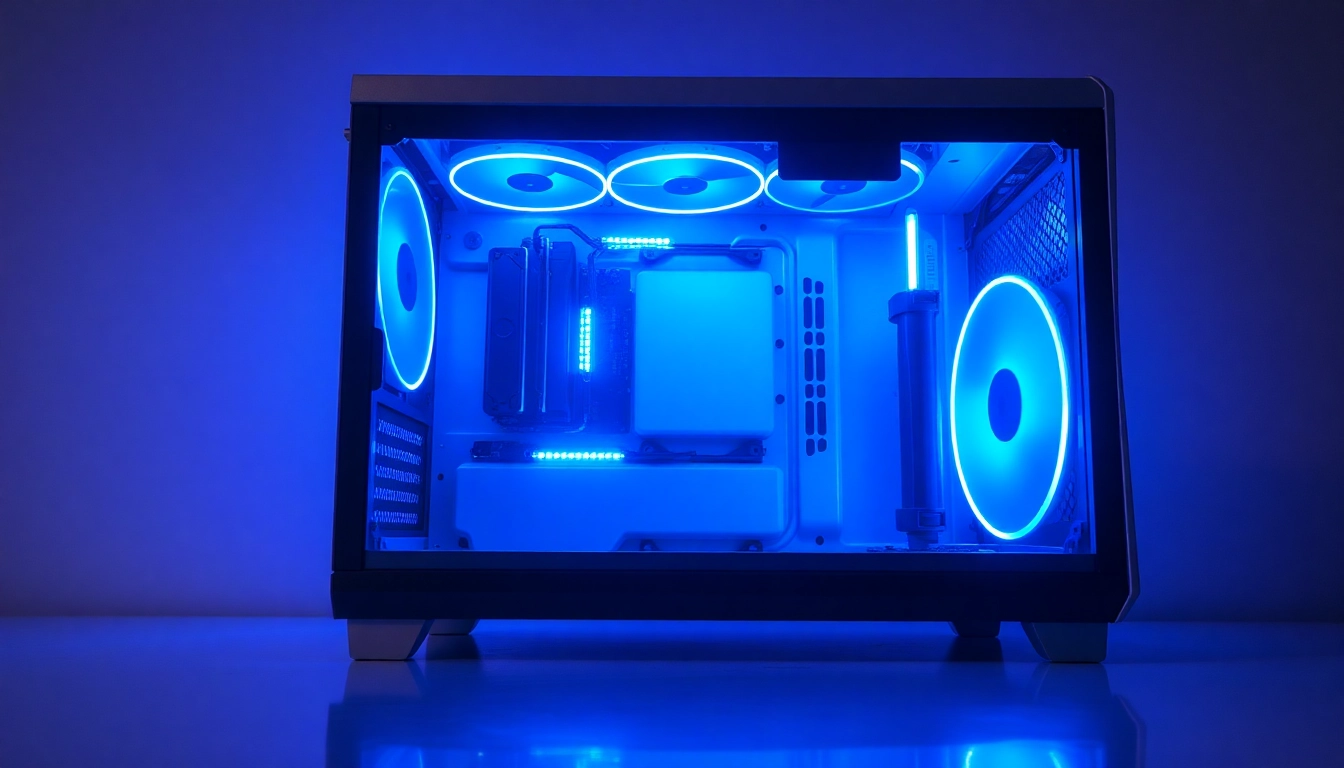Choosing the Right Gaming PC Case
When it comes to building a gaming PC, selecting the right gaming pc case is crucial. The case not only houses your components but also influences factors such as cooling, airflow, and aesthetics. Building a gaming rig can be exciting, but the wrong case can lead to performance issues or a cluttered setup. This guide will help you navigate through the choices and find the perfect case that fits your needs.
Importance of Size and Compatibility
One of the first considerations when selecting a gaming PC case is its size, which directly affects compatibility with your chosen components. Cases come in various form factors like ATX, Micro-ATX, Mini-ITX, and Full Tower. Understanding these options is vital:
- ATX Cases: Suitable for standard builds and provide ample space for components and cooling.
- Micro-ATX Cases: A slightly smaller option, great for budget-oriented builds without sacrificing too much space for expansion.
- Mini-ITX Cases: Perfect for compact builds, but they often limit upgrade options due to reduced space.
- Full Tower Cases: Ideal for high-performance setups, offering maximum cooling potential and space for additional components.
Measuring your motherboard and any additional hardware, such as GPUs and cooling solutions, can help ensure that everything fits comfortably within your selected case.
Factors to Consider: Cooling and Airflow
Cooling is critical in maintaining optimal performance for your gaming PC. A well-designed gaming PC case will support airflow through strategically placed fans and vents. Here are the cooling aspects to evaluate:
- Fan Compatibility: Check the number and size of fan mounts available in the case. Some cases feature RGB fans which improve both aesthetics and cooling.
- Airflow Design: Mesh panels or vents significantly enhance airflow and cooling efficiency.
- Liquid Cooling Support: If you plan on using liquid cooling, ensure your case can accommodate radiators and reservoirs.
The effectiveness of the cooling system can also impact the lifespan of your components. For instance, overheating issues can lead to throttling, thereby degrading gameplay experiences.
Design and Aesthetics that Stand Out
While functionality is paramount, the aesthetic appeal of your gaming PC case cannot be overlooked. Many gamers prefer to showcase their rigs, which is where design comes into play:
- Glass Panels: Cases with tempered glass side panels allow you to display your components and lighting settings.
- Color and Finish: Cases are available in various colors and finishes, from sleek mattes to vibrant paints.
- RGB Lighting: Integrated RGB options can create striking light shows, enhancing your gaming setup significantly.
Choosing a case that allows for customization not only enhances your gaming experience but also helps create a personal space that reflects your style.
Popular Types of Gaming PC Cases
Understanding the different types of gaming PC cases can help steer your decision toward the best fit for your needs. Here, we delve into some of the most popular styles:
Mid-Tower vs. Full-Tower: Which is Best?
Mid-tower and full-tower cases are commonly compared due to their size and functionality:
- Mid-Tower Cases: These are perfect for most gaming builds, offering adequate space for hardware while maintaining a moderate footprint. They typically support up to 6 fans and have space for multiple storage devices.
- Full-Tower Cases: Best for enthusiasts who want to maximize cooling and expandability with space for numerous components. Full-tower cases typically support larger GPUs, more storage drives, and multiple cooling solutions.
The choice between the two generally comes down to your specific needs—budget, space constraints, and the types of components you plan to install.
Compact Cases for Space-Saving Builds
If desk space is at a premium, compact cases, often in the Mini-ITX category, provide a viable alternative. These are designed for efficiency and can often fit powerfully in tight spots:
- Benefits: Compact cases maintain a small footprint, allowing more room on your desk for other peripherals.
- Challenges: Fewer expansion slots can limit the types of components you use, necessitating more careful selection.
Many compact cases now come with smart design features to optimize airflow and cooling despite their size, proving that good performance is achievable even in a smaller format.
Custom Cases for Unique Personalization
For enthusiasts who wish to express their individuality, custom cases present an exciting avenue. Customization can range from unique design modifications to personalized layouts:
- Unique Designs: Custom cases may feature unique shapes, finishes, and narrative-driven designs. The creative possibilities are virtually endless!
- DIY Builds: For those willing to put in a little extra effort, DIY cases made from different materials can offer a one-of-a-kind look.
- Water Cooling Integration: Many custom cases are designed with liquid cooling in mind, allowing for expansive cooling setups.
While custom cases can be pricier or require more effort to assemble, they often yield the most satisfying and visually impressive results.
Building Your Gaming PC: Steps to Follow
Building a gaming PC can be daunting for first-timers, but understanding the assembly process can make it straightforward and enjoyable. Here are key steps to follow:
Preparing Your Workstation for Assembly
Before diving into assembly, preparation is key. Ensure that you have a clean, static-free work environment and all necessary tools:
- Tools Needed: A Phillips screwdriver is usually sufficient for most builds. Anti-static wrist straps can help prevent shocking vital components.
- Clean Workspace: Clear off an area on your desk or table to prevent any obstructions or accidental damage to parts.
- Gather Components: Ensure you have all necessary components, including the GPU, motherboard, CPU, RAM, storage drives, power supply, and cooling solutions.
Installing Components Easily in a Gaming PC Case
Once your workstation is set up, installation can begin. Follow these essential steps:
- Install the Power Supply: Secure the PSU in the designated area and route cables for efficient organization.
- Attach the Motherboard: Ensure that standoffs are in place, then align your motherboard with the I/O shield and screw it in securely.
- Insert the CPU and RAM: Carefully place the CPU into its socket, lock it in, then insert the RAM into the designated slots.
- Install Storage Drives: Attach SSDs and HDDs in their designated bunkers, ensuring any cables are routed neatly.
- Graphics Card Installation: Lastly, insert your GPU into the PCIe slot and secure it.
Always refer to the manuals for each component for detailed instructions and diagrams for best results.
Common Mistakes to Avoid During Setup
Even seasoned builders can make mistakes. Here are some of the most common pitfalls to watch for:
- Neglecting BIOS Updates: Failing to update the BIOS can lead to compatibility issues, particularly with new hardware.
- Incorrect Cable Management: Poor cable management not only affects airflow but can also lead to future confusion during upgrades or repairs.
- Forgetting Thermal Paste: Proper application of thermal paste is vital for maintaining CPU temperatures—many users overlook this step and suffer thermal throttling.
Optimizing Your Gaming PC Case for Performance
After assembly, it’s time to focus on performance optimization through effective management techniques:
Managing Cables for Better Airflow
Cable management plays a crucial role in airflow efficiency. Here are several strategies to keep that airflow pristine:
- Use Cable Ties: Group cables together and secure them with ties to minimize clutter.
- Route Cables Behind the Motherboard Tray: Many cases allow you to hide cables behind the motherboard, enhancing aesthetics and airflow.
- Label Cables: For easier troubleshooting down the line, it’s also useful to label which cables go where.
Upgrading Cooling Solutions: Fans and Liquid Cooling
Upgrading your cooling solutions can lead to significant performance gains. Consider the following options:
- Adding Additional Fans: More fans can lead to better airflow. Consider intake and exhaust balance for optimum performance.
- Investing in Liquid Cooling Systems: Liquid cooling systems often provide superior cooling capabilities, especially under heavy workloads.
- Monitoring Temperatures: Software solutions can help keep tabs on your components’ temperatures, guiding necessary adjustments.
Enhancing Aesthetics with RGB Lighting
Don’t underestimate the impact of visual aesthetics on your gameplay experience. Here’s how to enhance your setup:
- Integrated RGB Solutions: Many cases come with built-in RGB fans and lighting options that can sync with your gaming peripherals.
- Customizable RGB Strips: Adding LED strips internally or externally can create a beautifully illuminated environment.
- Using RGB Software: Various manufacturers provide software to customize lighting, allowing for a synchronized look across your setup.
What to Look for When Buying a Gaming PC Case
Assemble a checklist of features to consider when purchasing your gaming PC case:
Guidelines on Budget vs. Premium Options
Price considerations can influence your selection of a gaming PC case:
- Budget Options: While inexpensive cases may lack certain features, many are fully functional for standard builds.
- Premium Cases: More expensive options usually come with enhanced build quality, better airflow, and additional features.
Assess your gaming needs against your budget to find the perfect balance—prioritizing essential features over aesthetics can often lead you to smart purchasing decisions.
User Reviews and Recommendations
Don’t overlook the importance of user input when selecting a case:
- Online Reviews: Websites like Tom’s Hardware and forums such as Reddit provide comprehensive reviews and user experiences.
- Community Feedback: Engaging with gaming communities often leads to suggestions based on actual usage.
Where to Find the Best Deals on Gaming PC Cases
Finding a good deal requires diligence. Here are some options for comparison shopping:
- eCommerce Platforms: Websites like Amazon, Newegg, and Best Buy frequently offer discounts and deals.
- Local Retailers: Don’t hesitate to check within local stores; sometimes in-person purchases provide advantages.
- Seasonal Sales: Keep an eye on Black Friday, Cyber Monday, and other holiday sales for substantial savings.



